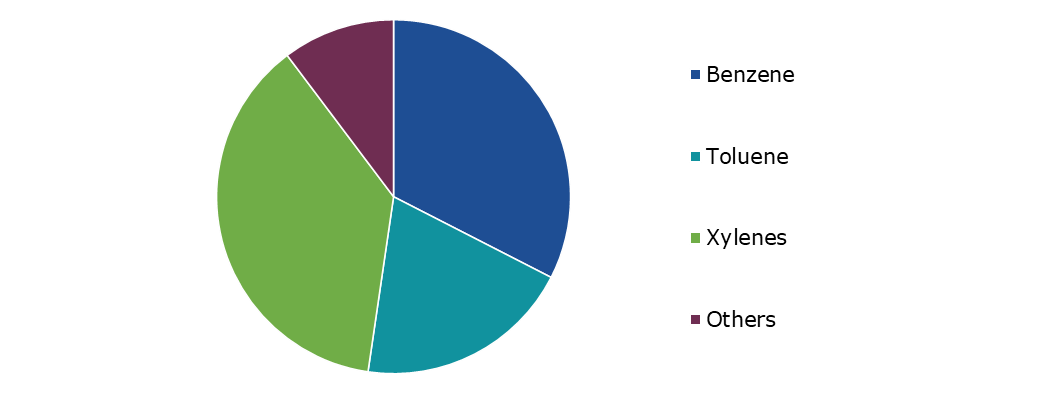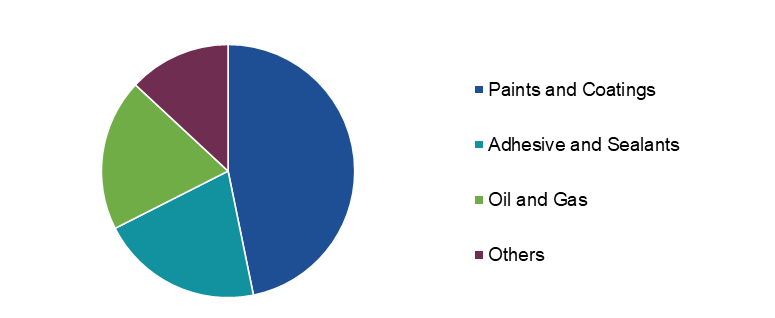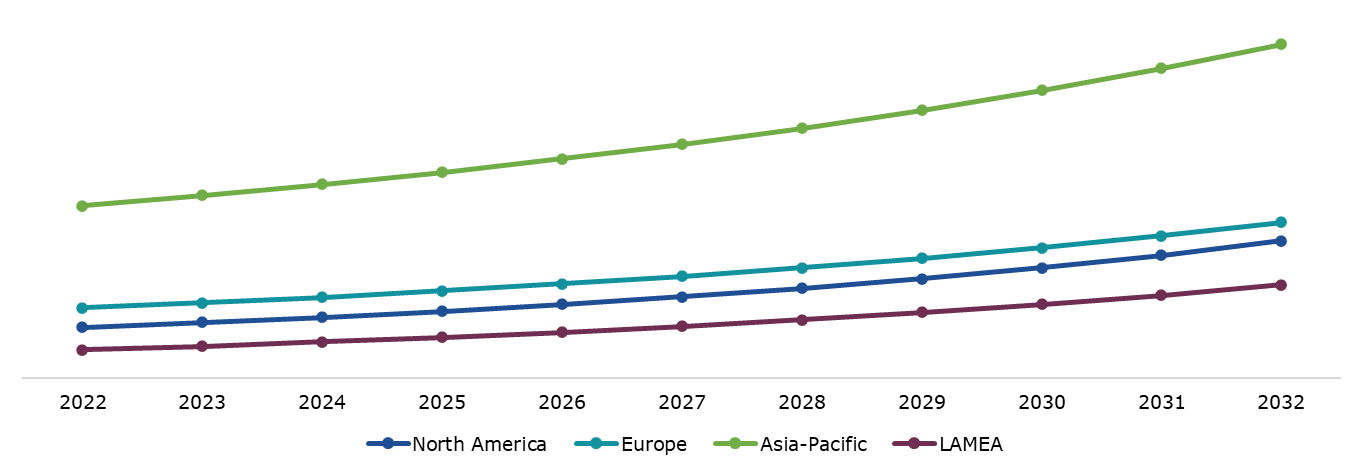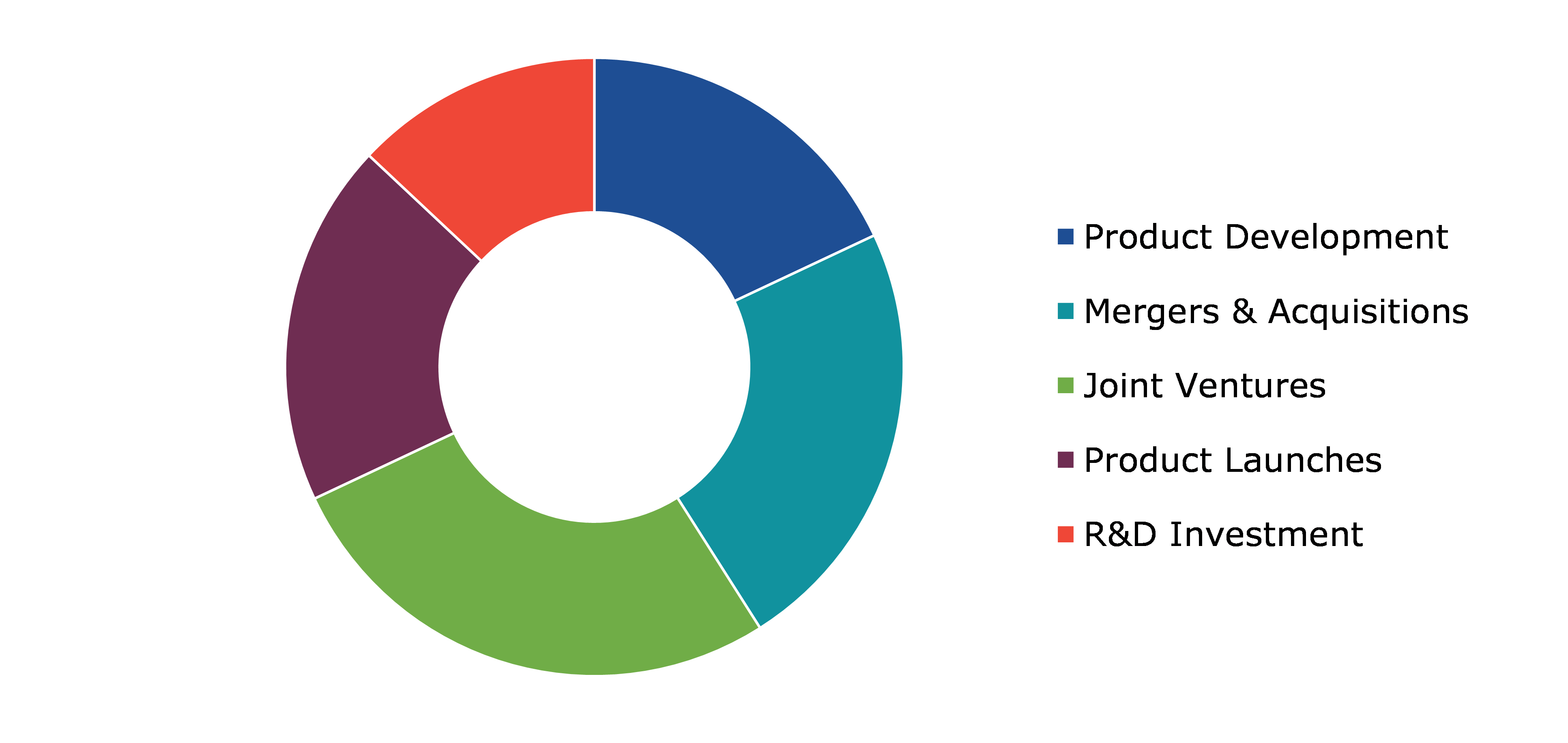Aromatic Solvent Market Report
RA09236
Aromatic Solvent Market by Type (Benzene, Toluene, Xylenes, and Others), Application (Paints & Coatings, Adhesive & Sealants, Oil & Gas, and Others), and Region (North America, Europe, Asia-Pacific, and LAMEA): Global Opportunity Analysis and Industry Forecast, 2023-2032
Aromatic Solvent Overview
Aromatic solvents depicted by their composition of aromatic hydrocarbons like naphtha, toluene, or xylene, play a pivotal role in a variety of industrial applications. Their primary function lies in their capacity to act as effective solvents and diluents across various sectors. Notably, toluene, a prominent member of the aromatic solvent family, finds widespread use in the formulation of paints, varnishes, adhesives, and even as a key component in chemical intermediates. The journey of these essential solvents often begins within the oil refining industry, where they are derived through the meticulous distillation of crude petroleum stock. This intricate process ensures the purity and reliability of the resultant aromatic solvents.
The versatility of aromatic solvents extends across a broad variety of industries. In industries including chemicals, petrochemicals, pharmaceuticals, and textiles, they are vital due to their versatility and efficiency. These solvents are crucial for creating different chemical compounds in the chemical industry. They are essential in the manufacturing of petrochemical derivatives, which is a segment of the petrochemical industry. To make pharmaceutical formulations and solutions, aromatic solvents are adopted. In the textile industry, these solvents are used for dyeing and printing processes. The widespread use of aromatic solvents in such diverse fields highlights their importance as a fundamental component of many industrial processes.
Global Aromatic Solvent Market Analysis
The global aromatic solvent market size was $104,929.0 million in 2022 and is predicted to grow with a CAGR of 2.9%, by generating a revenue of $138,838.4 million by 2032.
Source: Research Dive Analysis
COVID-19 Impact on Global Aromatic Solvent Market
The COVID-19 pandemic had a significant impact on the aromatic solvents industry. Aromatic solvents, which are hydrocarbon-based compounds with distinct aromatic properties, are commonly used in various applications, including the manufacturing of paints, coatings, adhesives, and chemical processes. The pandemic disrupted the global supply chain and caused several notable effects on this sector. With lockdowns and restrictions in place, many industries temporarily shut down or reduced their operations. This led to a decrease in demand for products that rely on aromatic solvents, such as automotive paints and construction materials. Consequently, some producers of these solvents experienced decreased sales and production volumes.
The post-pandemic period has led to a promising resurgence in the aromatic solvents industry, marked by several positive developments. As economies worldwide recover and industries regain their position, the demand for these specialized solvents is experiencing a gradual but steady rebound. Aromatic solvents are proving to be necessary in a diverse range of applications, including adhesives, sealants, and chemical manufacturing, which is playing a key role in driving the industry growth.
Rising Demand for Aromatic Solvent in Paints & Coatings to Drive the Market Growth
The paints and coatings industry has witnessed a substantial surge in the demand for aromatic solvents in recent years. This upward trajectory is primarily driven by the unique properties and versatile applications of these solvents within the sector. Aromatic solvents, derived from petroleum distillation, offer exceptional solvency power and mixing capabilities, making them a preferred choice for formulators and manufacturers in the paint and coatings industry. The performance and properties of many paint and coating compositions are greatly improved by aromatic solvents. They are commonly used in the creation of varnishes, enamels, and paintings with an oil basis. These solvents help dissolve pigments, binders, and resins to ensure that the paint or coating is applied evenly and smoothly. In order to achieve a consistent and appealing finish on varied surfaces, their capacity to lower viscosity and increase flow properties is crucial. In addition, it has been demonstrated that aromatic solvents are crucial in the creation of high-performance coatings for use in industrial and architectural applications. By encouraging adhesion and minimizing early peeling or degradation, they aid in the toughness and lifespan of coatings. Their use continues beyond traditional paints to include specialty coatings like automotive finishes, wood coatings, and protective coatings for steel and concrete structures.
Increasing Adoption of Bio-Based Solvent to Restrain the Market Growth
Aromatic solvent is facing challenge, owing to the rapidly growing use of bio-based solvents. Sustainability and environmental responsibility have gained importance on a worldwide scale in recent years. Because of this, customer preferences are now shifting towards more environmentally friendly options, and regulatory pressure is driving this trend. The use of renewable resources like plants provide a more sustainable and environmentally friendly alternative to traditional aromatic solvents, which are predominantly petroleum- and bio-based. The demand for aromatic solvents, which have been widely used in a number of industries including paints & coatings, adhesives, and medicines, is therefore projected to noticeably decline. In order for businesses to remain competitive in a world where environmental considerations are becoming more relevant in decision-making, the market for aromatic solvents may need to adapt and innovate as they search for more ecologically friendly and sustainable substitutes. This change denotes a major paradigm shift in the chemicals sector and emphasizes the significance of updating the product portfolio according to changing consumer preferences and legal requirements.
Surging Demand for Aromatic Solvent in the Automotive Sector to Drive Excellent Opportunities
The automotive industry is observing an increase in the need for aromatic solvents, which is excellent for the sector's growth and innovation opportunities. Aromatic solvents are known for their wide number of applications and are growing in demand, which is a key element in the market expansion. They are utilized in various processes in the automotive sector, owing to their outstanding characteristics, including their exceptional solvency, low volatility, and high chemical stability. These characteristics make them crucial for a variety of applications in the sector. In the automotive industry, the formulation of coatings and paints is where aromatic solvents are used most frequently. In order to improve the longevity and quality of automobile paints and ensure that vehicles retain their aesthetic appeal over time, aromatic solvents are essential. These solvents also assist in coating adherence to a variety of surfaces, improving the finish's overall quality and durability. The automotive industry's constant hunt for increased performance, safety, and sustainability is strongly linked to the increasing need for aromatic solvents. Aromatic solvents are essential in the production of innovative materials and composites as automakers work to create lighter and more fuel-efficient automobiles. These solvents are additionally used in the manufacture of fuels and lubricants for automobiles, improving the efficiency of the engines and lubricant use.
Global Aromatic Solvent Market Share, by Type, 2022
Source: Research Dive Analysis
The xylenes sub-segment accounted for the highest market share in 2022. Xylenes, a type of isomeric aromatic hydrocarbons, is experiencing a considerable increase in demand across a variety of industries owing to their solvent qualities and adaptability. The petrochemical, chemical, and manufacturing industries now depend heavily on aromatic solvents like ortho-, meta-, and para-xylene. These substances are essential for the creation of synthetic fibers, plastics, and a variety of chemical intermediates. The special chemical properties of xylenes make them ideal for a variety of applications. The production of paints, coatings, adhesives, and other chemical processes depends heavily on them. By allowing them to produce high-quality items and efficiently carry out chemical reactions, industries are able to meet the shifting demands of the global manufacturing and industrial sectors.
In addition, the necessity of aromatic solvents particularly xylenes in the petrochemical sector is driving up demand for them. These hydrocarbons are important raw materials for making essential materials and chemicals which help to produce a wide range of products. The demand for such solvents rises along with the expansion of both global industrialization and urbanization. Xylene is a key component in the creation of materials that promote the development of transportation, consumer goods, and infrastructure, making it an important link in the global supply chain.
Global Aromatic Solvent Market Share, by Application, 2022
Source: Research Dive Analysis
The paints & coatings sub-segment accounted for the highest market share in 2022. The paint and coatings industry is experiencing a remarkable surge in demand for aromatic solvents, and this trend can be attributed to their unique chemical properties and remarkable versatility in various applications. Derived primarily from petroleum sources, these solvents have gained significant traction as they play a vital role in formulating a wide range of paints and coatings. Aromatic solvents have become integral to meet the stringent industry standards when it comes to product durability and longevity. They are the key element in ensuring that paints and coatings perform exceptionally well in diverse and challenging conditions. These solvents are essential in formulating coatings that can stand the test of time, providing surfaces with long-lasting protection against a variety of environmental stressors. Moreover, aromatic solvents are helpful in preventing moisture-induced damage. By effectively preventing moisture and humidity, they safeguard coatings against the deteriorative effects of water infiltration, ensuring that surfaces remain intact and visually appealing.
Global Aromatic Solvent Market Size & Forecast, by Region, 2022-2032 ($Million)
Source: Research Dive Analysis
The Asia-Pacific aromatic solvent market generated the highest revenue in 2022. The demand for aromatic solvents has significantly increased in the region recently, which has led to a substantial shift in the sector. The region's economic growth and quick industrial expansion have been the main causes of this increase in demand. Aromatic solvents have become highly adaptable compounds that play vital roles as diluents, solubilizing agents, and essential elements in a wide range of chemical reactions with a special emphasis on their use in the manufacture of paints & coatings, adhesives, and rubber products. The booming automotive sector of Asia-Pacific is also seeing an increase in demand for aromatic solvents which is not just restricted to paints and coatings. As this sector continues to flourish, aromatic solvents have become indispensable in various aspects of vehicle manufacturing, prominently in the production of automotive paints and coatings. Their use is helpful in ensuring the durability and aesthetic appeal of automobiles, aligning with the high standards demanded by this fast-growing industry. The increasing dominance of aromatic solvent in several industrial fields is the cause of their adaptability and versatility. They play a crucial role in upholding the high standards of excellence demanded by the expanding economy of Asia-Pacific and serve as crucial elements in the development of high-quality products. Aromatic solvents are positioned to maintain their dominance as industries develop and grow by meeting the rising demand for their useful uses in chemical processes, paints, coatings, adhesives, rubber goods, and automobile manufacture. Asia-Pacific is at the forefront of this progressive movement, and the increase in demand for these solvents reflects how quickly and dynamically the sector is changing.
Competitive Scenario in the Global Aromatic Solvent Market
Product launch, investment, and acquisition are common strategies followed by major market players. For instance, in 2021, LyondellBasell Industries Holdings B.V. made an announcement regarding its operations in Pasadena, Texas. The company showcased plans to undertake a significant expansion of its facility, primarily with the aim of expanding the production of benzene and numerous other chemicals. This strategic development was prompted by the essential need to fulfill the rising demand for benzene and other aromatic solvents within the market.
Source: Research Dive Analysis
Some of the leading aromatic solvent market players are ExxonMobil Chemical Company, LyondellBasell Industries Holdings B.V, Royal Dutch Shell plc, Total S.A, Chevron Phillips Chemical Company LP, CEPSA Química S.A, SK Global Chemical Co Ltd, Eastman Chemical Company, Sasol Limited, and PetroChina Company Limited.
| Aspect | Particulars |
| Historical Market Estimations | 2020-2021 |
| Base Year for Market Estimation | 2022 |
| Forecast Timeline for Market Projection | 2023-2032 |
| Geographical Scope | North America, Europe, Asia-Pacific, and LAMEA |
| Segmentation by Type |
|
|
Segmentation by Application
|
|
| Key Companies Profiled |
|
Q1. What is the size of the global aromatic solvent market?
A. The size of the global aromatic solvent market was $104,929.0 million in 2022 and is projected to reach $138,838.4 million by 2032.
Q2. Which are the major companies in the aromatic solvent market?
A. ExxonMobil Chemical Company, LyondellBasell Industries Holdings B.V, Royal Dutch Shell plc, Total S.A, Chevron Phillips Chemical Company LP, CEPSA Química S.A, SK Global Chemical Co Ltd, Eastman Chemical Company, Sasol Limited, and PetroChina Company Limited are some of the key players in the global aromatic solvent market.
Q3. Which region, among others, possesses greater investment opportunities in the future?
A. Asia-Pacific possesses great investment opportunities for investors in the future.
Q4. What will be the growth rate of the Asia-Pacific aromatic solvent market?
A. The Asia-Pacific aromatic solvent market is anticipated to grow at 2.7% CAGR during the forecast period.
Q5. What are the strategies opted by the leading players in this market?
A. Product launches and investment are the two key strategies opted by the operating companies in this market.
Q6. Which companies are investing more on R&D practices?
A. ExxonMobil Chemical Company, LyondellBasell Industries Holdings B.V, and Royal Dutch Shell plc are the companies investing more on R&D activities for developing new products and technologies.
1. Research Methodology
1.1. Desk Research
1.2. Real time insights and validation
1.3. Forecast model
1.4. Assumptions and forecast parameters
1.5. Market size estimation
1.5.1. Top-down approach
1.5.2. Bottom-up approach
2. Report Scope
2.1. Market definition
2.2. Key objectives of the study
2.3. Report overview
2.4. Market segmentation
2.5. Overview of the impact of COVID-19 on global aromatic solvent market
3. Executive Summary
4. Market Overview
4.1. Introduction
4.2. Growth impact forces
4.2.1. Drivers
4.2.2. Restraints
4.2.3. Opportunities
4.3. Market value chain analysis
4.3.1. List of raw material suppliers
4.3.2. List of manufacturers
4.3.3. List of distributors
4.4. Innovation & sustainability matrices
4.4.1. Technology matrix
4.4.2. Regulatory matrix
4.5. Porter’s five forces analysis
4.5.1. Bargaining power of suppliers
4.5.2. Bargaining power of consumers
4.5.3. Threat of substitutes
4.5.4. Threat of new entrants
4.5.5. Competitive Rivalry Intensity
4.6. PESTLE analysis
4.6.1. Political
4.6.2. Economical
4.6.3. Social
4.6.4. Technological
4.6.5. Environmental
4.7. Impact of COVID-19 on aromatic solvent market
4.7.1. Pre-covid market scenario
4.7.2. Post-covid market scenario
5. Aromatic Solvent Market Analysis, by Type
5.1. Overview
5.2. Benzene
5.2.1. Definition, key trends, growth factors, and opportunities
5.2.2. Market size analysis, by region, 2022-2032
5.2.3. Market share analysis, by country, 2022-2032
5.3. Toluene
5.3.1. Definition, key trends, growth factors, and opportunities
5.3.2. Market size analysis, by region, 2022-2032
5.3.3. Market share analysis, by country, 2022-2032
5.4. Xylenes
5.4.1. Definition, key trends, growth factors, and opportunities
5.4.2. Market size analysis, by region, 2022-2032
5.4.3. Market share analysis, by country, 2022-2032
5.5. Others
5.5.1. Definition, key trends, growth factors, and opportunities
5.5.2. Market size analysis, by region, 2022-2032
5.5.3. Market share analysis, by country, 2022-2032
5.6. Research Dive Exclusive Insights
5.6.1. Market attractiveness
5.6.2. Competition heatmap
6. Aromatic Solvent Market Analysis, by Application
6.1. Overview
6.2. Paints & Coatings
6.2.1. Definition, key trends, growth factors, and opportunities
6.2.2. Market size analysis, by region, 2022-2032
6.2.3. Market share analysis, by country, 2022-2032
6.3. Adhesive & Sealants
6.3.1. Definition, key trends, growth factors, and opportunities
6.3.2. Market size analysis, by region, 2022-2032
6.3.3. Market share analysis, by country, 2022-2032
6.4. Oil & Gas
6.4.1. Definition, key trends, growth factors, and opportunities
6.4.2. Market size analysis, by region, 2022-2032
6.4.3. Market share analysis, by country, 2022-2032
6.5. Others
6.5.1. Definition, key trends, growth factors, and opportunities
6.5.2. Market size analysis, by region, 2022-2032
6.5.3. Market share analysis, by country, 2022-2032
6.6. Research Dive Exclusive Insights
6.6.1. Market attractiveness
6.6.2. Competition heatmap
7. Aromatic Solvent Market, by Region
7.1. North America
7.1.1. U.S.
7.1.1.1. Market size analysis, by Type, 2022-2032
7.1.1.2. Market size analysis, by Application, 2022-2032
7.1.2. Canada
7.1.2.1. Market size analysis, by Type, 2022-2032
7.1.2.2. Market size analysis, by Application, 2022-2032
7.1.3. Mexico
7.1.3.1. Market size analysis, by Type, 2022-2032
7.1.3.2. Market size analysis, by Application, 2022-2032
7.1.4. Research Dive Exclusive Insights
7.1.4.1. Market attractiveness
7.1.4.2. Competition heatmap
7.2. Europe
7.2.1. Germany
7.2.1.1. Market size analysis, by Type, 2022-2032
7.2.1.2. Market size analysis, by Application, 2022-2032
7.2.2. UK
7.2.2.1. Market size analysis, by Type, 2022-2032
7.2.2.2. Market size analysis, by Application, 2022-2032
7.2.3. France
7.2.3.1. Market size analysis, by Type, 2022-2032
7.2.3.2. Market size analysis, by Application, 2022-2032
7.2.4. Spain
7.2.4.1. Market size analysis, by Type, 2022-2032
7.2.4.2. Market size analysis, by Application, 2022-2032
7.2.5. Italy
7.2.5.1. Market size analysis, by Type, 2022-2032
7.2.5.2. Market size analysis, by Application, 2022-2032
7.2.6. Rest of Europe
7.2.6.1. Market size analysis, by Type, 2022-2032
7.2.6.2. Market size analysis, by Application, 2022-2032
7.2.7. Research Dive Exclusive Insights
7.2.7.1. Market attractiveness
7.2.7.2. Competition heatmap
7.3. Asia-Pacific
7.3.1. China
7.3.1.1. Market size analysis, by Type, 2022-2032
7.3.1.2. Market size analysis, by Application, 2022-2032
7.3.2. Japan
7.3.2.1. Market size analysis, by Type, 2022-2032
7.3.2.2. Market size analysis, by Application, 2022-2032
7.3.3. India
7.3.3.1. Market size analysis, by Type, 2022-2032
7.3.3.2. Market size analysis, by Application, 2022-2032
7.3.4. Australia
7.3.4.1. Market size analysis, by Type, 2022-2032
7.3.4.2. Market size analysis, by Application, 2022-2032
7.3.5. South Korea
7.3.5.1. Market size analysis, by Type, 2022-2032
7.3.5.2. Market size analysis, by Application, 2022-2032
7.3.6. Rest of Asia-Pacific
7.3.6.1. Market size analysis, by Type, 2022-2032
7.3.6.2. Market size analysis, by Application, 2022-2032
7.3.7. Research Dive Exclusive Insights
7.3.7.1. Market attractiveness
7.3.7.2. Competition heatmap
7.4. LAMEA
7.4.1. Brazil
7.4.1.1. Market size analysis, by Type, 2022-2032
7.4.1.2. Market size analysis, by Application, 2022-2032
7.4.2. UAE
7.4.2.1. Market size analysis, by Type, 2022-2032
7.4.2.2. Market size analysis, by Application, 2022-2032
7.4.3. Saudi Arabia
7.4.3.1. Market size analysis, by Type, 2022-2032
7.4.3.2. Market size analysis, by Application, 2022-2032
7.4.4. South Africa
7.4.4.1. Market size analysis, by Type, 2022-2032
7.4.4.2. Market size analysis, by Application, 2022-2032
7.4.5. Rest of LAMEA
7.4.5.1. Market size analysis, by Type, 2022-2032
7.4.5.2. Market size analysis, by Application, 2022-2032
7.4.6. Research Dive Exclusive Insights
7.4.6.1. Market attractiveness
7.4.6.2. Competition heatmap
8. Competitive Landscape
8.1. Top winning strategies, 2022
8.1.1. By strategy
8.1.2. By year
8.2. Strategic overview
8.3. Market share analysis, 2022
9. Company Profiles
9.1. ExxonMobil Chemical Company
9.1.1. Overview
9.1.2. Business segments
9.1.3. Product portfolio
9.1.4. Financial performance
9.1.5. Recent developments
9.1.6. SWOT analysis
9.2. LyondellBasell Industries Holdings B.V.
9.2.1. Overview
9.2.2. Business segments
9.2.3. Product portfolio
9.2.4. Financial performance
9.2.5. Recent developments
9.2.6. SWOT analysis
9.3. Royal Dutch Shell plc
9.3.1. Overview
9.3.2. Business segments
9.3.3. Product portfolio
9.3.4. Financial performance
9.3.5. Recent developments
9.3.6. SWOT analysis
9.4. Total S.A.
9.4.1. Overview
9.4.2. Business segments
9.4.3. Product portfolio
9.4.4. Financial performance
9.4.5. Recent developments
9.4.6. SWOT analysis
9.5. Chevron Phillips Chemical Company LP
9.5.1. Overview
9.5.2. Business segments
9.5.3. Product portfolio
9.5.4. Financial performance
9.5.5. Recent developments
9.5.6. SWOT analysis
9.6. CEPSA Química S.A.
9.6.1. Overview
9.6.2. Business segments
9.6.3. Product portfolio
9.6.4. Financial performance
9.6.5. Recent developments
9.6.6. SWOT analysis
9.7. SK Global Chemical Co Ltd.
9.7.1. Overview
9.7.2. Business segments
9.7.3. Product portfolio
9.7.4. Financial performance
9.7.5. Recent developments
9.7.6. SWOT analysis
9.8. Eastman Chemical Company
9.8.1. Overview
9.8.2. Business segments
9.8.3. Product portfolio
9.8.4. Financial performance
9.8.5. Recent developments
9.8.6. SWOT analysis
9.9. Sasol Limited
9.9.1. Overview
9.9.2. Business segments
9.9.3. Product portfolio
9.9.4. Financial performance
9.9.5. Recent developments
9.9.6. SWOT analysis
9.10. PetroChina Company Limited.
9.10.1. Overview
9.10.2. Business segments
9.10.3. Product portfolio
9.10.4. Financial performance
9.10.5. Recent developments
9.10.6. SWOT analysis
Personalize this research
- Triangulate with your own data
- Request your format and definition
- Get a deeper dive on a specific application, geography, customer or competitor
- + 1-888-961-4454 Toll - Free
- support@researchdive.com






